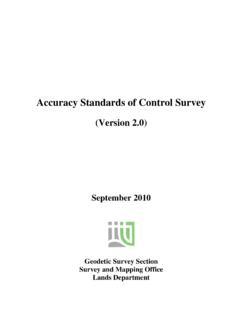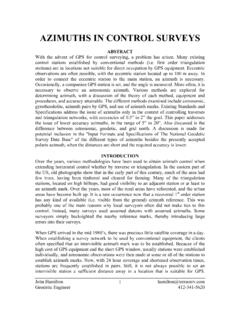Transcription of 1.0 Conversion Factors - michigan.gov
1 SOM CSS Lidar Specifications, 2012 Derived from the USGS Lidar Base specification Version Page | 1 Conversion Factors Altitude and Elevation, as used in this report, refers to the distance above the geoid, unless specifically referenced to the ellipsoid. Height, as used in this report, refers to the height above ground. Multiply By To obtain Length centimeter (cm) inch (in.) meter (m) foot (ft) kilometer (km) mile (mi) meter (m) yard (yd) Area square meter (m2) acre square meter (m2) square foot (ft2) hectare (ha) acre hectare (ha) square mile (mi2) = 640 acres = 1 section square kilometer (km2) acre square kilometer (km2) square mile (mi2)
2 SOM CSS Lidar Specifications, 2012 Derived from the USGS Lidar Base specification Version Page | 2 Abbreviations and Acronyms ASPRS American Society for Photogrammetry and Remote Sensing CLICK Center for Lidar Information, Coordination, and Knowledge CONUS Conterminous United States CORS Continuously Operating Reference Stations CVA Consolidated Vertical Accuracy DEM Digital Elevation Model DSM Digital Surface Models DTED digital terrain elevation data DTM digital terrain model EDNA Elevation Derivatives for National Applications EPSG European Petroleum Survey Group FGDC Federal Geographic Data Committee FOV field of view FVA Fundamental Vertical Accuracy GB gigabyte GPS Global Positioning System GSD ground sample distance H&H hydraulic and hydrologic IFSAR Interferometric Synthetic Aperature
3 Radar lidar light detection and ranging IMU Inertial Measurement Unit NAD83 North American Datum of 1983 NAVD88 North American Vertical Datum of 1988 NDEP NEEA National Digital Elevation Program National Enhanced Elevation Assessment NED National Elevation Dataset NGP National Geospatial Program NGS National Geodetic Survey NIR near infra-red NIST National Institute of Standards and Technology NPS Nominal Pulse Spacing NSRS National Spatial Reference System NSSDA National Standards for Spatial Data Accuracy OCONUS Outside the Conterminous United States QA/QC Quality Assurance/Quality Control RMSE SOM Root Mean Square Error State of michigan SVA Supplemental Vertical Accuracy TIN Triangulated Irregular Network USGS Geological Survey UTM Universal Transverse Mercator XML eXtensible Markup Language SOM CSS Lidar Specifications, 2012 Derived from the USGS Lidar Base specification Version Page | 3 Introductory Material Purpose and Scope The State of michigan (SOM) intends to use this specification to acquire and procure light detection and ranging (lidar)
4 Data, and to create consistency across all SOM and partner funded lidar collections. Most of the information in this specification was extracted from the USGS Lidar Base specification Version ( ; Heidemann, Hans Karl, 2012, Lidar base specification version , Geological Survey Techniques and Methods, book 11, chap. B4, 63 p.). While changes have been made to various sections to improve the applicability for the SOM and its partners, the specification still meets USGS standards. Also, some sections have been purposely excluded but still apply to this specification . In addition to reviewing this document, vendors responding to Request for Proposals for SOM lidar data collection should reference the following sections in the USGS Lidar Base specification Version : Glossary (for terminology) Appendix 4.
5 Lidar Metadata Example Appendix 5. Lidar Metadata Template It must be emphasized that this is a base specification , defining minimum parameters for acceptance of the acquired lidar data. It is expected that local conditions in any given project area, specialized applications for the data, or the preferences of cooperators, may mandate more stringent requirements. The SOM encourages the collection of more detailed, accurate, or value-added data. A list of common upgrades to the minimum requirements defined in this report is provided in appendix 1. Applicability These specifications and guidelines are applicable to lidar data and deliverables supported in whole or in part, with either financial or in-kind contributions, by the SOM and/or the USGS.
6 Warranty Against Data Defects Defects in imagery collection that are reported by the customer within 90 days shall be corrected by re-acquisition and re-processing. Defects in image processing reported by the customer within 12 months shall be corrected by re-processing. SOM CSS Lidar Specifications, 2012 Derived from the USGS Lidar Base specification Version Page | 4 Collection Multiple Discrete Returns Data collection must be capable of at least three returns per pulse. Full waveform collection is acceptable and welcomed; however, waveform data are regarded as supplemental information.
7 Deriving and delivering multiple discrete returns is required in all cases. Intensity Values Intensity values are required for each return. The values are to be recorded in the .las files in their native radiometric resolution. Nominal Pulse Spacing (NPS) A NPS of at least 2 points per square meter is required. Dependent on the local terrain and land cover conditions in the project area, a greater point density may be required on specific projects. Assessment of the NPS will be made against single swath, first-return only data, located within the geometrically usable center portion (typically 90 percent) of each swath, acceptable data voids excluded.
8 NPS will be calculated as the square root of the average area per point. Average along-track and cross-track point spacing should be comparable (within 10 percent). In general, the target NPS for a project should not be achieved through swath overlap or multiple passes. Such collection techniques may be permitted with prior approval. Data Voids Data voids within a single swath are not acceptable, except in the following circumstances: Where caused by water bodies, Where caused by areas of low near infra-red (NIR) reflectivity such as asphalt or composition roofing, or Where appropriately filled-in by another swath.
9 Spatial Distribution The spatial distribution of geometrically usable points is expected to be uniform. Although it is understood that lidar instruments do not produce regularly gridded points, collections should be planned and executed to produce a first-return point cloud that approaches a regular lattice of points, rather than a collection of widely spaced high density profiles of the terrain. The uniformity of the point density throughout the dataset is important and will be assessed using the following steps: Generating a density grid from the data with cell sizes equal to the design NPS times 2, using a radius equal to the design NPS.
10 Ensuring at least 90 percent of the cells in the grid contain at least one lidar point. The assessment is to be made against individual (single) swaths, using only the first-return points located within the geometrically usable center portion (typically 90 percent) of each swath. Excluding acceptable data voids previously identified in this specification . Note: This requirement may be relaxed in areas of substantial relief where it is impractical to maintain a consistent and uniform distribution. Note: The process described in this section relates only to the uniformity of the point distribution.
















